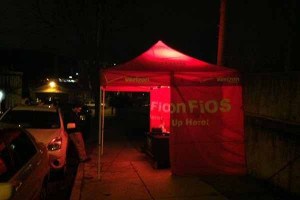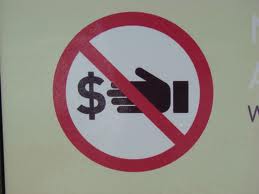
Although Verizon Communications has stopped expanding its FiOS fiber-to-the-home service outside of areas it already committed to serve, its gradual rollout continues in Philadelphia.
Gradual is right. On Kalos Street in the Wissahickon section of Philly, it all depends on which side of the road your house resides. Odd-numbered customers were in luck this week as Verizon took its marketing efforts to the street, with a temporary tent emblazoned with Verizon’s logo installed on the sidewalk, giving pedestrians a few minutes of warmth from a portable heater.

FiOS tent (Courtesy: J. Chakars/WHYY NewsWorks)
Inside the tent, would-be customers are given a preview of the fiber optic service and some free gifts just for stopping by on the cold winter night. Those who took Verizon up on its offer walked away with free ice skating tickets. Those that didn’t got a refrigerator magnet and a tote bag as consolation prizes.
Verizon’s sales force, braving the weather, has made inroads in the city that is home to Comcast’s corporate headquarters.
Joanne Weill-Greenberg told WHYY/NewsWorks she called Comcast to deal for a lower rate and Comcast refused to match Verizon FIOS’ introductory offer. She is now an ex-Comcast customer, and not just for the money. She explained FiOS offers channels Comcast does not carry, and because FiOS also carries Comcast’s regional sports channel, there is nothing holding them to the cable company.
The Verizon tent does not stay in any one location too long.
In a few days, they will relocate to another neighborhood that is now primed for fiber upgrades from the phone company.
Pennsylvania residents can just be thankful the winter weather has not gotten brutal enough for Verizon to deploy its inflatable igloo.


 Subscribe
Subscribe All new homes must be equipped with fiber broadband connections if they are located in a county or city where fiber service is provided, according to a new mandate from China’s Ministry of Industry and Information Technology.
All new homes must be equipped with fiber broadband connections if they are located in a county or city where fiber service is provided, according to a new mandate from China’s Ministry of Industry and Information Technology.
 A CenturyLink official made a remarkable concession in the state of Minnesota last week when he admitted the state’s community-owned broadband networks are better equipped to deliver 21st century broadband speeds that CenturyLink simply cannot provide.
A CenturyLink official made a remarkable concession in the state of Minnesota last week when he admitted the state’s community-owned broadband networks are better equipped to deliver 21st century broadband speeds that CenturyLink simply cannot provide.


 “I want FiOS yesterday. I guess some of these building owners already have it and will let us have it if the kickback is finally high enough. Time Warner Cable comes and goes whenever they like.”
“I want FiOS yesterday. I guess some of these building owners already have it and will let us have it if the kickback is finally high enough. Time Warner Cable comes and goes whenever they like.”